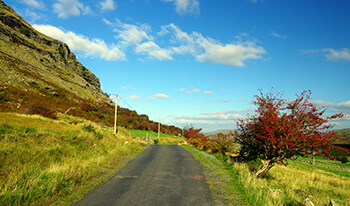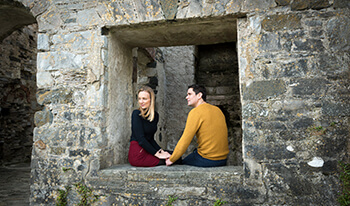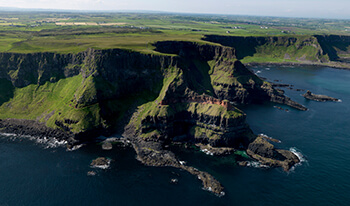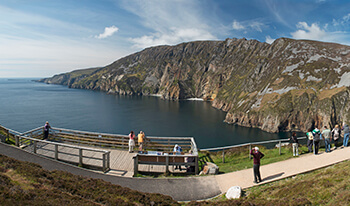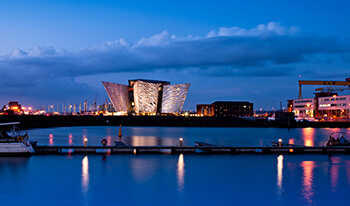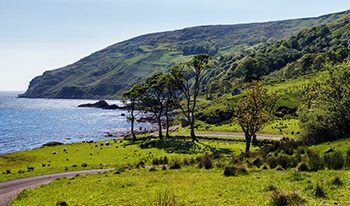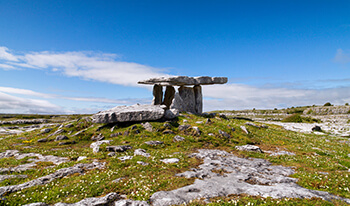Glencolmcille Folk Village Museum is a cluster of several typical Irish cottages, known as a ‘clachan’, perched on a hillside overlooking the sandy cove of Glen Bay Beach in the Irish-speaking area (Gaeltacht ) of South West Donegal. Built and managed by local people, the folk village is one of Ireland's best living-history museums.
Each dwelling is a replica of a cottage used by the local people in the 18th- 20th centuries and is complete with the furniture, artifacts and utensils that would have been used at the time. You will also find a reconstructed school house, fisherman’s dwelling and tiny pub-grocer that offer additional insights into rural Irish life in one of the most remote areas of Ireland.
Glencolmcille Folk Village Museum is located in a towb by the same name, Glencolmcille. Gleann Cholm Cille is still an Irish-speaking community though this is in decline; English has became the predominant language in recent years.
The name translates into English as the Valley of Saint Columba. Saint Columba (Irish: Colm Cille) is one of Ireland's three patron saints (along with Saint Patrick and Saint Brigid). Colm Cille and his followers lived in the valley and the ruins of several of their churches can still be seen there. Following a dispute with the church about the right to copy religious manuscripts, Colm Cille went into exile on the isle of Iona off the west coast of Scotland.
Between 4000 and 3000 BC, farming people settled in the area and excellent examples of their court tombs can be seen at Mainnéar na Mortlaidh and An Clochán Mór. Examples of the less-elaborate portal tombs, dating from about 2000 BC can also be seen at Málainn Mhóir.
The town was once famous as being the parish of controversial Father McDyer (1910-1987), who championed the rights of rural people and helped establish community-based industries in the area. Father McDyer's business methods were sometimes ill-considered and managed, however, and many of the business ventures were failures, often for fundamental reasons. The more successful ventures were the folk village and shop and the hotel in nearby Malin Mor.
A Parish Council has been functioning in Glencolmcille since the 1930s - known as Comhairle Paróiste Ghleann Cholm Cille. Members are elected to this body by the residents of the Glencolmcille Church area with elections being held every three years. The main purpose/objective of Comhairle Pharóiste Ghleann Cholm Cille is to look after the interests and needs of the residents of Glencolmcille.
Glencolmcille is the home of the well known Dublin-born artist, Kenneth King. His works depict naval and merchant shipping, coastline and lighthouses.
British composer Sir Arnold Bax made many extended visits there between 1904 and the early 1930s. Apparently, Bax composed much of his music and wrote many of his poems and stories while staying there.
Many natural beauties lie nearby, such as the Slieve League (Irish: Sliabh Liag) cliffs, the Silver Strand (Irish: An Tráigh Bhán) at Malin Beg (Irish: Málainn Bhig), and Glen Head (Irish: Cionn Ghlinne) itself.
The town is well-known today as the home of Oideas Gael, an Irish language learning institute established in 1984 to promote the Irish language and culture. The town also has a petrol station, grocer, post office, folk village, woollen mill, hill walking and accommodation centre, restaurant, new "village cafe" and three pubs (with great fiddle music often to be found in Roarty's or Biddy's). The coast road across to Malin Mor (Irish: Málainn Mhór) is majestic and is where Áras Ghleann Cholm Cille is located.
Tours featuring this attraction
Peace of Mind Guarantee
Your trip, worry free!Our Ireland based team is on call throughout your vacation!

